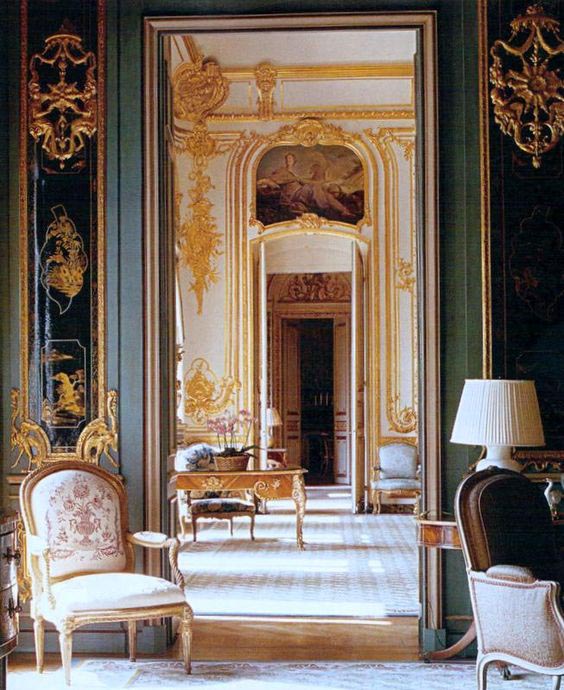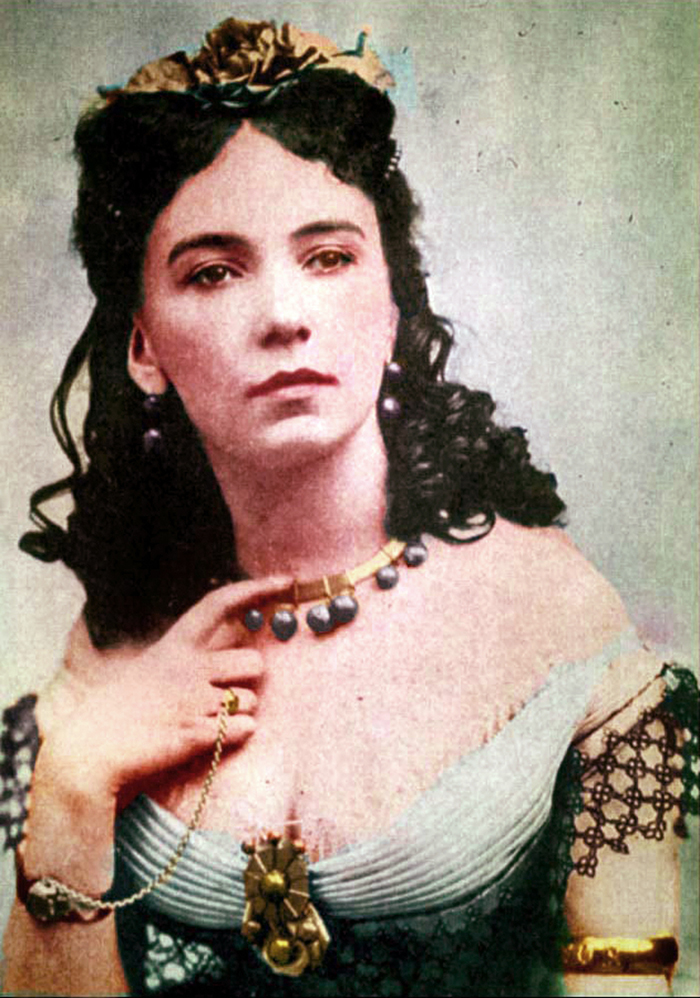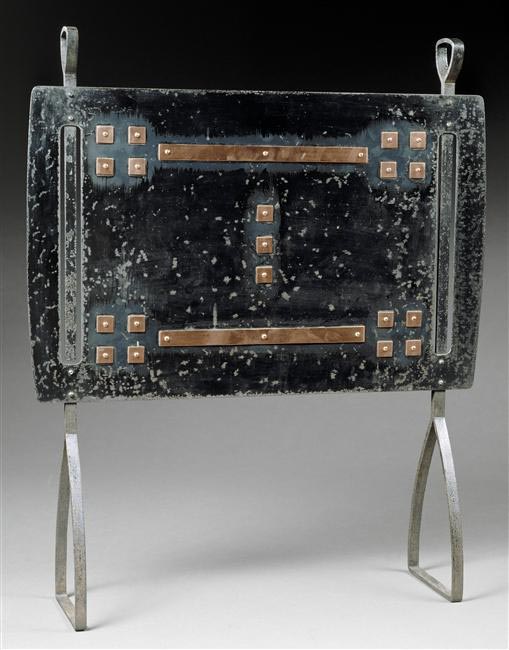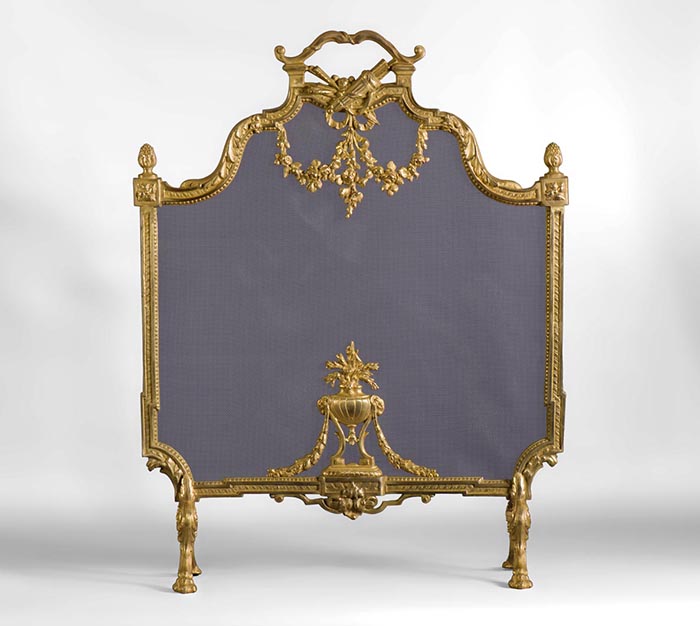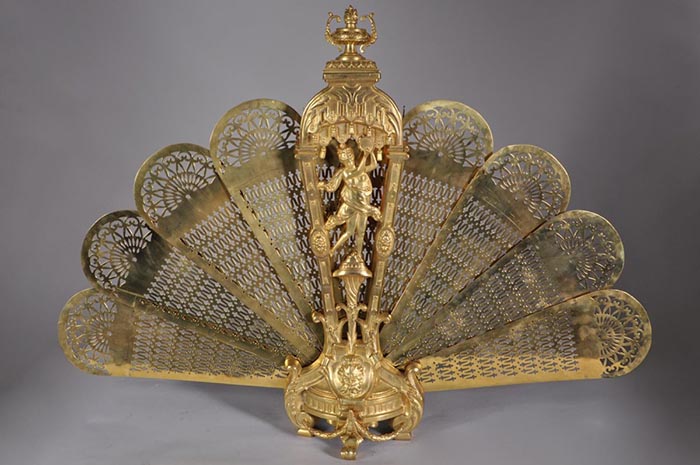The Firescreen
Download PDFAn essential accessory to prevent from blaze, the “pare-étincelles” firescreen made of wire-mesh and set on bronze is typical of the Second Empire. It figures among the fireplace screens, also named fireguards. In 19th century, it was tirelessly recommended for the children and lady’s safety, “whose clothes might so easily ignite”.
Protecting from the projections of the fire, it has the advantage of being an elegant decoration element when the fire has died out, and allows to gaze at the roaring fire, not being dazzled. It figures more broadly among mantel ornaments, as well as andirons, spades and tongs, ashtrays, etc.
18th century princely furniture knows the carpeted firescreens, beautiful cloths set on wood frames, but those are still very flammable and hide the comforting show of fire burning in the hearth. Georges Jacob, the most renowned carpenter of the Grand Style, let several beautiful examples, including the screen of Marie-Antoinette’s Room in the Petit Trianon.
In the beginning of 19th century, the carpeted firescreens still prevail, sometimes only humble canvas arranged by the stove like that of Delacroix’s Corner of the Studio. The Directoire takes this decorative vocabulary again, imposing its more severe style, as testifies Marcion’s firescreen, created in 1800 and held in the Compiègne Palace.
But the notion of “pare-étincelles” suddenly appears in the middle of 19th century, industrially fast-growing, about a new form of wire-meshed screens. An inventor named Delacour patents in 1854 his “anti-sparkle blind-screen”, of uncoiling silk mesh, adapting to every fireplace. He gets a medal of honor for this invention in 1855, and supplies the Emperor Napoleon III. This event seems to open a new market and creates and emulation of creativeness about the “pare-étincelles”.
On one side, the functional “pare-étincelles”, a simple iron-mesh or pierced sheet metal, spreads in the public buildings, administrative offices and schools in particular, in the 1870 decade. On the other side, decorative models of “pare-étincelles” compete in luxury to seduce the customer and replace the carpeted screens. In 1862, Jules Vuigner, bronze maker, patents a “sort of mobile anti-sparkle fireguard”, when in the meantime at the World's Fair of 1867 , Desbordes exhibits his lavish mantel ornaments of gilded bronze, varnished bronze and polished brass.
Private mansions get from now on modern “pare-étincelles” firescreens of bronze or brass, which styles evoke the splendor of Louis XV and Louis XVI’s reigns. In the shape of a fan, or with baroque outlines, many display ornaments such as branches or symbols of love. The Hotel of Pontalba on the faubourg Saint-Honoré, housing nowadays the USA Embassy, held before 1876 a “pare-étincelles firescreen in gilded bronze and openwork”. Such objects garnished before 1877 Cora Pearl’s private mansion in Chaillot street, a notorious demi-mondaine close to Louis-Napoleon Bonaparte and the Duke of Morny.
The firecreen doesn’t escape from the Art Nouveau esthetic experiments in Sérurier-Bovy’s mind, which shows its importance in modern interiors.
Bibliography
Patents :
Catalogue des brevets d'invention, Paris, J. Tremblay, 1854, brevet du 10 décembre 1854.
Almanach impérial (...) présenté à Leurs Majestés, Paris, Guyot et Scribe, 1858.
Bulletin des lois de la République française, 1864, p. 199
Public equipment in « pare-étincelles » :
Ernest Bosc, Encyclopédie générale de l'architecte-ingénieur. Traité complet théorique et pratique du chauffage et de la ventilation des habitations particulières et des édifices publics, Paris, Morel, 1875.
Alexis Pothuau, Règlement sur l'ameublement des bureaux et postes divers des établissements de la marine, Paris, E Lacroix, 1878.
Sales displaying gilded bronze pare-étincelles firescreens between 1876 and 1911 :
Riff, Horsin Déon, Catalogue du riche mobilier et des objets d'art garnissant l'hôtel de Pontalba, vente 14-16 juin 1876.
Charles Mannheim, Catalogue des mobilier, argenterie, objets d'art et tableaux garnissant l'hôtel de Mlle Cora Pearl, vente 24-25 mai 1877.
Vignères, Estampes anciennes et modernes, chromolithographies, etc., vente 1er juin 1878.
E. Féral, Catalogue des tableaux anciens et modernes, objets d'art, (...) garnissant l'hôtel de feu M. Martin Coster, vente 10 mai 1880.
B. Lasquin, Beau mobilier, bronzes d'art de Bardedienne, émaux cloisonnés (…), vente 1892.
Charles Mannheim, Objets d'art et de curiosité, porcelaines et faïences (…), vente 1892.
A. Bloche, Catalogue d'un beau mobilier époques et styles Renaissance et XVIIIe siècle, bronzes d'art et d'ameublement (…), vente 1895.
Charles Mannheim, Catalogue des objets d'art et d'ameublement, porcelaines de Chine, objets variés (...) appartenant à monsieur le comte de S. R., vente 1911.









